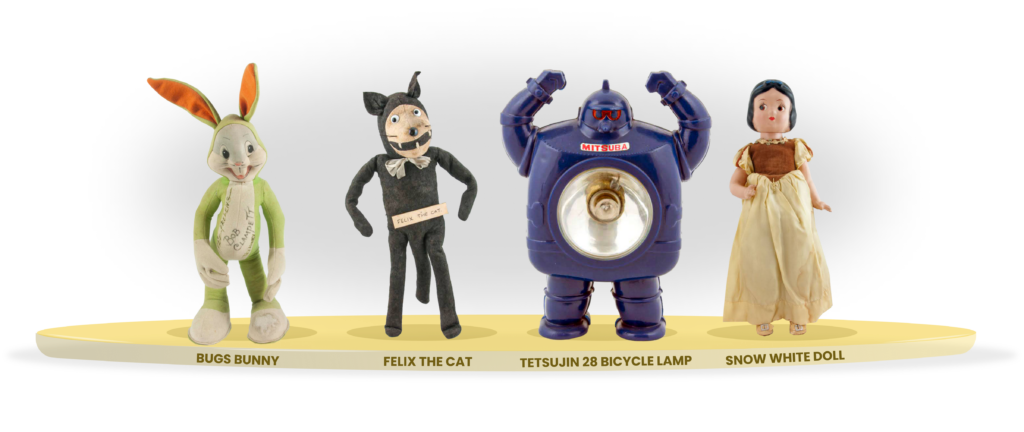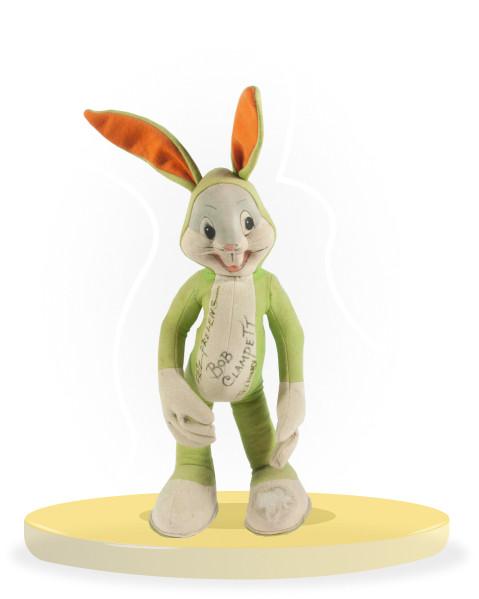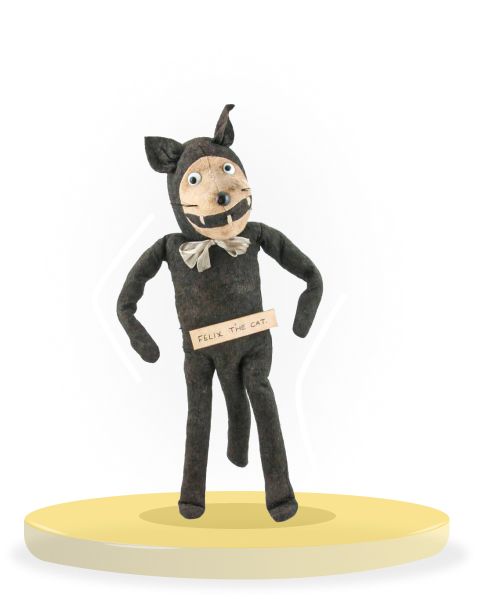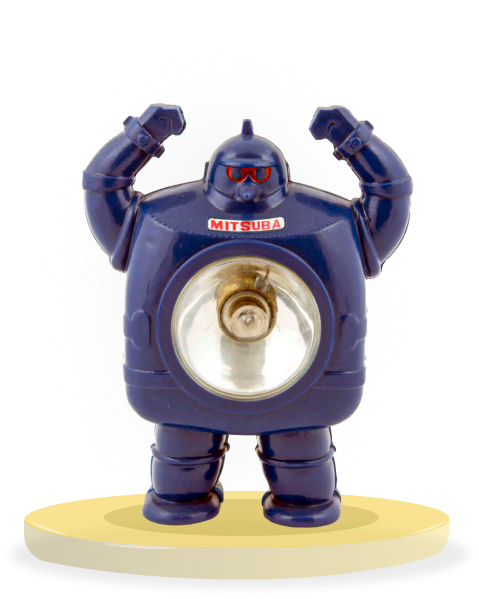
With the emergence of cinematic animations in the 1920s as well as the golden age of comic books in the 1930s, cartoon animations and comic books eventually became the primary entertainment for both children and adults alike. A variety of characters portrayed in the animations and comic books had also become icons of popular culture. With the popularity and the marketability of these iconic characters, many toy makers and manufacturers found character toys to be most profitable to mass produce. Today, toys which depict popular comic books, cartoons and movie characters remain the most mass produced and manufactured toys in the industry. These toys not only served as complementary merchandise but also eventually became novelty objects for collectors.


The exhibition explores a variety of character toys ranging from the collection of Cartoon Animations which document some of the popular animation production houses. Following the rise of Hollywood, the exhibition also highlights the characters from the Silent Film era and also delves deep into the World of Comic Books from the 1920s to the 1950s. In addition, the exhibition also spotlights some of the classic Disney fables and fairytales.

Cartoon animations have been one of the biggest drives for the production of toys for children. Originating from 2D hand drawn characters from frame to frame, these cartoons became the one of the favourite entertainments among children. Since they were so popular, production houses would collaborate with toy makers to produce merchandise to commercialise these animated characters.
Under the collection of Cartoon Animations, the selection of toys highlights some of the popular cartoon animation characters such as Bugs Bunny, Tom and Jerry, and Popeye from Looney Tunes, Thimble Theatre and Hanna Barbera respectively.

Looney Tunes
On April 17, 1930, the very first Warner Bros. Looney Tunes cartoon, Sinkin’ in the Bathtub, was released. It featured Bosko, a wide-eyed character that bore an uncanny resemblance to Otto Messmer’s anthropomorphic black cat, Felix the Cat. The animated film’s bawdy humour was an immediate hit among moviegoers, and the cartoon concluded with a famous phrase that would later become a Looney Tunes trademark – “That’s all, folks!”
Since its founding, the Looney Tunes, alongside Merrie Melodies, were designed with one goal in mind: to be an iconoclastic alternative to Disney’s revolutionary Silly Symphonies. Rather than creating shorts that aim to elevate the art of animation, Warner Bros.’ team of writers and directors sought to make animated cartoons that would make people laugh.
Throughout the 1930s and ‘40s, an assemblage of notable characters made their screen debut, including Porky Pig, who stuttered his first dialogues in I Haven’t Got a Hat (1935); Daffy Duck, the foil to Porky Pig, made his first appearance in Porky’s Duck Hunt (1937); and Bugs Bunny, a flippant and frivolous rabbit that made its debut in an Oscar-nominated A Wild Hare (1940).
Unfortunately, the era of theatrical animated shorts drew to a close in the 1960s. However, the Looney Tunes brand remained profitable and was later repackaged under various names, becoming a staple in Saturday morning cartoons. In fact, the brand was once again repackaged in 2020 and gave birth to the Looney Tunes Cartoons series, which premiered as part of the HBO Max streaming service. These shorts range from one to six minutes in length and they sought to revive this endearing franchise by taking cues from the Looney Tunes glory years of the 1940s and ‘50s

Bugs Bunny
Row 1 Shelf 1
In 1944, producer Leon Schlesinger sold the rights to his “Looney Tunes” and “Merrie Melodies” characters to Warner Bros, who immediately began producing licensed merchandise which proudly bore the new copyright – “Warner Bros. Cartoons.”
This 1940s “Bugs Bunny” doll was one of the first Bugs Bunny dolls to ever be released by the Warner Bros. This style of doll – which depicts the rabbit in a brightly coloured body suit with a felt collar, holding a stuffed carrot – was a common design that was reproduced by companies such as M & H Novelty Corporation and Marben Limited. Many other colours and sizes were produced, including pink, white, blue, and yellow variations.
What sets the museum’s copy of this doll apart from others’ are the two signatures on Bugs Bunny’s torso, provided by Bob Clampett and Tex Avery. Together, Clampett and Avery were responsible for creating Bugs’ iconic design and quick-witted personality, and Avery is credited with writing his well-known catchphrase, “What’s up, Doc?”

Bugs Bunny
Maker
Year of Make
Material
Country of Origin
Unknown
c.1930s
Felt and Fabric
United States of America

In the height of the silent film era from the early 1910s to the late 1920s, motion pictures grew into maturity which sparked the beginnings of Hollywood. Although silent films were without voiced sound, they were often accompanied with instrumental music and captions. The age of silent films was historically named as an era of artistic innovation which also marked the start of slapstick comedy in film.
Under the collection of Silent Film, our vintage toys will feature the iconic pioneer characters during the golden age of silent films in the 1920s through the collection of Felix the Cat, Betty Boop and Charlie Chaplin.

Felix the Cat
First debuted in the 1919 short silent film Feline Follies, Felix the Cat was one of the first animated characters to hit the silver screen. Felix’s star power had no trouble drawing in audiences, who flocked to cinemas to enjoy his onscreen antics. This mischievous, anthropomorphic black cat was not only popular with the generic public, but also among the critics and was recognised as an excellent example of surrealism in filmmaking.
Its origins remain disputed – Australian cartoonist-film entrepreneur Pat Sullivan had claimed to be the cat’s creator. However, the American animator Otto Messmer, Sullivan’s lead animator, has been credited as such. What is certain is that Felix was created in Sullivan’s studio, and films and comic strips featuring the character enjoyed significant success. Aside from the animated shorts and comic strips, Felix started to appear as a muse and mascot for sodas, professional sports teams, a Daniel Arsham sculpture, and even an active US Navy’s Bombing Squadron nicknamed the Tomcatters.
By the late 1920s, Felix’s success quickly faded due to the arrival of sound cartoons. The new Disney animated shorts of Mickey Mouse made the silent Felix appear outdated. Pressured to keep up with the trend, Sullivan tried to make the transition by distributing Felix sound cartoons through Copley Pictures, but this venture was deemed a failure.
By the late 1920s, Felix’s success quickly faded due to the arrival of sound cartoons. The new Disney animated shorts of Mickey Mouse made the silent Felix appear outdated. Pressured to keep up with the trend, Sullivan tried to make the transition by distributing Felix sound cartoons through Copley Pictures, but this venture was deemed a failure.
Despite being past his prime, television would prove to be the cat’s saviour, and Felix cartoon began airing once again in 1953. Alongside Felix, other characters were introduced in the new series, such as Poindexter and Rock Bottom. This television series allowed Felix to jump-start another round of success, and the cat has since starred in various television programmes and feature films. Aside from vintage collectibles, many brands like Levi ‘s and Urban Outfitters have launched collections that feature this well-loved black cat.

Felix the Cat Fabric Doll
Row 3 Shelf 2
Schuco was established in 1912 as Schreyer and Co – after founder Heinrich Schreyer – but changed their name to the more catchy “Schuco” in 1921. While initially known for their mechanical tin toys, Schuco followed in the footsteps of other German toymakers and began producing soft stuffed dolls, including teddy bears and other animals. These dolls featured innovative flexible limbs, rather than jointed ones, creating endless posing possibilities.
This “Felix the Cat Fabric Doll” was produced by Schuco in the 1930s. Created in 1919 by Pat Sullivan and Otto Messmer, Felix the Cat was an instant success – his star power drew audiences into the cinema to see his new theatrical shorts, which were released every two weeks. In 1923 alone, Sullivan made $100,000 from licensing the Felix character, whose image was made into soft toys, such as this one, and other objects like ceramics, toy figures and postcards. This doll features a gap-toothed design typical of early Felix the Cat stuffed toys, which were also made by other companies like Steiff, East London Toy Company, and Dean’s Rag Company.

Felix the Cat Fabric Doll
Maker
Year of Make
Material
Country of Origin
Schuco
c.1920s
Fabric
Germany

During the 1930s, the rise of comic books gave birth to many of the renowned superheroes we know today. Particularly in the United States, the introduction of superheroes in the landscape of World War II was a form of morale booster for the country.
In Japan, on the other hand, most of the comic books feature android superheroes which reflects the landscape of the Cold War and technological competition. In addition to familiar American comics and Japanese Manga, syndicated comic strips were also published on a schedule in both magazines and newspaper prints.
Under the collection of World of Comic Books, our selection of toys will feature some of the iconic superheroes from the United States, Japan and Belgium through the collection of Japanese Manga, American Comics, and the Franco-Belgian Bandes Dessinees respectively.

Japanese Manga
One of the most well-known modern Japanese art forms today is Manga, or Japanese-style cartoons. The term is a general category, and encompasses all types of genres including Shonen manga (aimed at young male readers), Shojo manga (aimed at young female readers), and traditional genres such as comedy, romance, adventure, mystery, and even horror. Most Manga today is first published sequentially in Manga magazines such as Weekly Shonen Jump, Weekly Shonen Magazine, and Ciao.
More successful series are compiled into standalone Manga volumes for translation or publication, and many popular Manga series are also transformed into animated cartoon shows called Anime.
The origins of certain elements of Manga can be traced back to the 12th century, but a significant turning point for the category was the immense cultural shifts in Japan post-World War II. Some of the most influential Manga ever were published during this period including Astro Boy (1951) and Sazae-San (1946) which would influence decades of Manga artists and comic books to come. The creator of Astro Boy – Osamu Tezuka (1928-89) – is still regarded today as one of the greatest Manga artists of all time for his boundary-pushing work in the art form.
Today the Manga market is one of the biggest comic book markets in the world with large audiences domestically and overseas; in 2020, the North American Manga market alone was valued at almost USD250 Million. Many Manga series over the decades have achieved worldwide fame and popularity including One Piece (1997-present), Dragon Ball (1984-95), Naruto (1999-2014), Demon Slayer: Kimetsu no Yaiba (2016-20), Bleach (2001-16), Fullmetal Alchemist (2001-10), Hunter x Hunter (1998-18, on hiatus), and Boys Over Flowers (1992-2003).

Tetsujin 28 Bicycle Lamp
Row 4 Shelf 3
Established in 1946, Mitsuba started out as a modest Japanese manufacturer of generator lamps for bicycles. Over the course of the 20th century, they would grow to be a major corporation comprising 47 companies, listed on the Tokyo Stock Exchange.
This “Tetsujin 28-go Bicycle Lamp” was produced in Mitsuba’s early days, between the 1950s to 1960s. During this period, the Tetsujin 28-go manga was being published in Kobunsha’s Shōnen Magazine. This serialisation ran from July 1956 to May 1966, and was widely read by many children across Japan, including aspiring manga artists like Go Nagai, creator of robot series Mazinger Z.
In the past, it was common to have a generator lamp mounted on the front of a bicycle, which would use the motion from pedalling to generate power. This product depicts Tetsujin 28-go raising its arms, with a battery-powered bicycle lamp in the middle of its torso, and would have brought a simple joy to children familiar with the manga series.

Tetsujin 28 Bicycle Lamp
Maker
Year of Make
Material
Country of Origin
Unknown
c.1960s
Plastic
Japan

Throughout a century of The Walt Disney Company since the 1920s, Disney has evolved from cartoon animations and adaptations of classical fables to creating their original series of modern day fairy tales that are relatable to children and adults alike. In addition to their animation and cinematic empire, Disney has diversified their business into theme parks and merchandise.
Under the collection of Disney, our selection of toys will feature some of the familiar Walt Disney Classic Fables and Fairytales through the collection of Mickey Mouse and Friends, Pinocchio, as well as Snow White and the Seven Dwarfs.

Walt Disney Classic Fables and Fairytales
One of the biggest multimedia franchises today is undeniably the various cartoons, movies, and toys created by the Walt Disney Company. From original characters like Mickey Mouse & Friends to adaptations of classic fables and fairytales to original plots with a strong focus on family-friendly entertainment, Disney has created dozens of characters over the years beloved by children and adults alike.
The Disney company was originally founded in October 1923 by Walt and Roy Disney. Roy handled the business side of the company, whereas Walt (as an artist and animator) spearheaded the creation of the iconic character Mickey Mouse alongside legendary animator Ub Iwerks. Mickey first appeared in the 1928 animated short “Steamboat Willie”, which was the first post-produced sound cartoon. Since then, Mickey has become one of the most recognisable cartoon characters worldwide along with his friends Minnie Mouse, Donald Duck, and Goofy to name a few.
Mickey and friends have even appeared in their own animated television series and films including Fantasia (1940), A Goofy Movie (1995), and Disney’s House of Mouse (2001-03).
In 1937, Disney released “Snow White and the Seven Dwarfs”, the first full-length traditionally animated feature film and an adaptation of the traditional fairy tale by the Brothers Grimm. Following Snow White’s success, more animated fairy tale adaptations would soon follow including Pinocchio (1940), Sleeping Beauty (1959), and more recent films such as The Princess and the Frog (2009), Tangled (2010), and Frozen (2013).

Snow White and the Seven Dwarfs
Row 6 Shelf 5
The merchandising for Disney’s 1937 film “Snow White and the Seven Dwarfs” was extensive and unprecedented. As Disney’s first feature-length film, it was ensured that Snow White-related merchandise was being sold to the public before the film had even premiered, to ensure widespread awareness of the characters in the lead-up to the film’s release day.
In total, 147 companies were granted licenses to manufacture over 2,000 different Snow White products, consisting of sheet music, dolls, puzzles, soap, balloons, clothing, and even food products like ham and bacon. These efforts were a tremendous success – over a period of six months following the film’s release, more than $2,000,000 worth of Snow White toys alone were sold.
Following the film’s premiere, many toy and dollmakers jumped on the marketing bandwagon, including the Knickerbocker Toy Company. The company released this “Snow White Doll” in a set with seven dwarfs; the doll itself was available in different sizes, ranging 11, 15, and 20 inches. This 15 inch doll wears a brown and yellow silken dress, and captures the character’s wide-eyed innocence which won the hearts of audiences around the world.

Snow White Doll
Maker
Year of Make
Material
Country of Origin
Knickerbocker Toy Co. Inc.
c.1937–1949
Painted Composition and Fabric
United States of America

